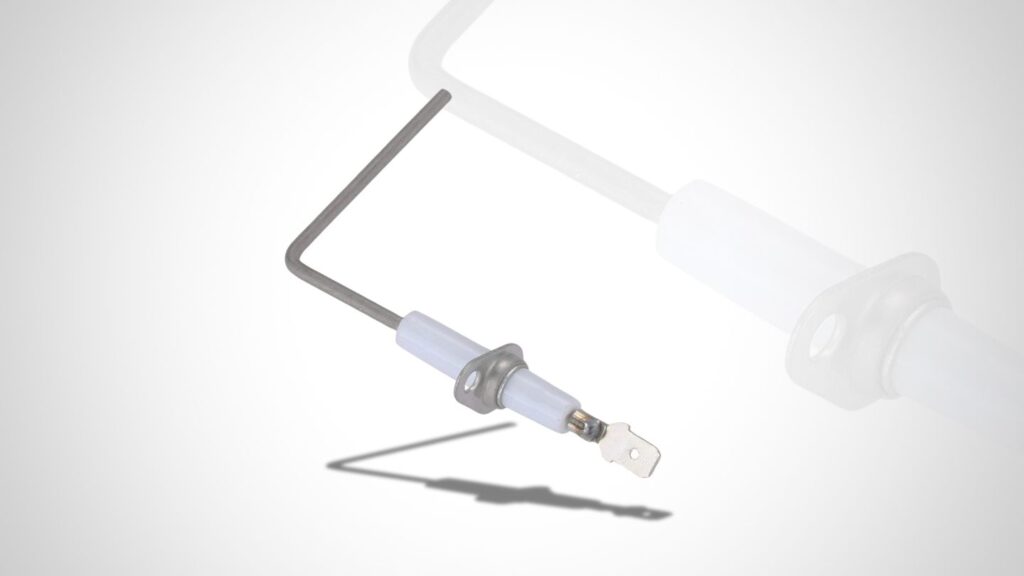What Does a Furnace Flame Sensor Do?
A furnace flame sensor plays a key role in your gas furnace’s safety, ensuring that the burner flame is present. If no flame is detected, it automatically shuts off the gas flow to prevent any leaks or potential hazards. In this blog, we’ll go over what a furnace flame sensor does, how it works, warning signs of a bad furnace flame sensor, and some simple maintenance tips to keep your gas furnace operating properly and efficiently.
Key Takeaways
- The furnace flame sensor is essential for safety, detecting flames to prevent gas leaks and dangerous issues like carbon monoxide poisoning.
- Regular maintenance of the furnace’s flame sensor, including cleaning and timely replacement, can enhance the furnace’s efficiency, extend its lifespan, and help reduce energy costs.
- Warning signs of a failing sensor, such as frequent furnace short cycling, higher energy bills, and yellow burner flames, indicate the need for attention.
Understanding the Furnace Flame Sensor
The flame sensor is a small metal rod attached near the burner assembly inside your heating unit. Its purpose is straightforward: to detect whether a flame is present when the gas valve opens. If no flame is detected, the sensor signals the furnace to shut off the gas supply. This safety feature prevents unburned gas from escaping, reducing the risk of carbon monoxide build-up or even explosions.
If you’re looking to locate the flame sensor, it’s typically inside the furnace’s access panel near the furnace burners. To access it, you will need to remove the furnace access cover, which may involve unscrewing or unbolting it. Its role in sensing the flame makes it a critical component for both safety and effective heating. Proper functioning of this part is vital for furnaces, as well as maintaining overall indoor air quality.
How Does a Furnace Flame Sensor Work?
A furnace flame sensor works by detecting heat from the furnace burners. When the burners ignite, the sensor picks up the heat and sends an electrical signal to the control board to confirm a flame is present. If it doesn’t sense heat, the sensor immediately instructs the heating system to stop gas flow. This quick reaction ensures that only burning gas is released, maintaining a safe environment. For homes with ductwork systems or air handlers, a working flame sensor ensures proper airflow and temperature regulation throughout the home, improving energy efficiency and comfort.
Importance of the Furnace Flame Sensor in Preventing Carbon Monoxide Poisoning

Without a functioning flame sensor, the heating system could allow unburned gas to leak into your home, posing serious health and safety risks, including carbon monoxide poisoning. If no flame is detected within about a few seconds, the sensor shuts down the furnace to prevent hazardous leaks.
Signs Your Furnace Flame Sensor Might Be Failing
Recognizing when your furnace has a bad flame sensor can prevent costly repairs and keep your home safe. Common signs include:
- Frequent On-and-Off Cycling (Short Cycling): Known as short cycling, this occurs when the sensor fails to detect the flame, causing early shutoffs.
- Higher Energy Bills: When the sensor malfunctions, your furnace may use more energy, leading to increased costs.
- Yellow Burner Flames: Yellow flames indicate incomplete combustion, a sign of a faulty or broken flame sensor.
How to Maintain Your Furnace Flame Sensor
Routine maintenance of the furnace’s flame sensor ensures its effectiveness and longevity. Here’s a quick guide:
- Safety First: Turn off both the gas supply and electricity to the furnace.
- Remove the Sensor: Carefully take the flame sensor out from the furnace’s access panel.
- Cleaning: Gently remove soot with an emery cloth or soft cloth, or sand off any stubborn residue. Avoid aggressive cleaners, as they could damage the sensor.
- Reinstall: Place the sensor back, turn on the gas and electricity, and test to ensure everything runs correctly.
Read more: Top Tips on How to Maintain Furnace and Save Money
Replacing a Faulty Furnace Flame Sensor

While flame sensors can last around two decades, they may need replacing sooner if they’re damaged. Warning signs of a faulty sensor include cracks in the porcelain casing, scorching, or broken parts. Since replacement requires handling the gas line, consider scheduling a furnace repair service to guarantee safe and accurate installation.
Benefits of Professional Furnace Maintenance
Keeping up with heating unit maintenance ensures:
- Enhanced Efficiency: A clean flame sensor allows the heating unit to run efficiently, reducing energy costs.
- Extended Lifespan: Routine maintenance prolongs your heating unit’s life.
- Prevention of Breakdowns: Routine checks catch potential issues early, avoiding expensive repairs.
- Improved Safety: Proper maintenance minimizes carbon monoxide risks and ensures safe operation.
Conclusion
In summary, the furnace flame sensor is vital for your furnace’s safety and efficiency within the broader context of the heating and cooling system. Understanding its role, recognizing failure signs, and following maintenance guidelines are key to preventing hazards and ensuring your furnace operates smoothly.
At Total Comfort Cooling & Heating Inc., we’re dedicated to helping our clients maintain safe, efficient, and reliable heating systems. Our team offers comprehensive HVAC services near Venice, Rotonda, Punta Gorda, North Port, Manasota, and surrounding areas, including expert furnace inspections and maintenance. If you’re concerned about your furnace flame sensor or just want to ensure your system is operating at peak efficiency, our experienced technicians are here to assist. From servicing air conditioners and furnaces to maintaining indoor air quality and providing expert care for commercial services, our team has you covered. Let us ensure your heating system runs smoothly all winter long—reach out to us today for a service that brings comfort, efficiency, and peace of mind.
Frequently Asked Questions
How often should I clean my furnace flame sensor?
It’s recommended that the flame sensor be cleaned once a year to ensure it functions properly. Regular cleaning prevents soot and residue build-up, which can impair the sensor’s ability to detect flames accurately. Additionally, checking and replacing air filters regularly is crucial, as dirty air filters can lead to inefficiencies in the furnace’s operation and contribute to high energy bills.
What happens if I ignore a faulty flame sensor?
Ignoring a faulty flame sensor can lead to furnace shutdowns, inefficient heating, higher energy bills, and safety risks like gas leaks or carbon monoxide build-up. Additionally, a malfunctioning sensor may fail to detect flame burns within the burner assembly, increasing the risk of fire hazards. Addressing issues with the sensor promptly ensures safe and efficient operation.
How long does a furnace flame sensor last?
A flame sensor can typically last around 15 to 20 years, but this varies based on usage and maintenance. Regular cleaning and timely replacements ensure it remains in good working condition.
Is it normal for the furnace flame sensor to cause the furnace to cycle on and off?
Frequent cycling may indicate a dirty or malfunctioning flame sensor. Short cycling is often a sign that the sensor isn’t detecting the flame consistently, which can cause the furnace to turn off prematurely. Cleaning or replacing the sensor usually resolves this issue.
READY FOR YOUR NEXT HEATING OR COOLING PROJECT?
Contact us to get a quote and see why our customer service is recognized as the best in the industry.






 Special Offer: 12 Months - No Interest, No Payments!
Special Offer: 12 Months - No Interest, No Payments!